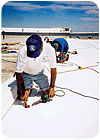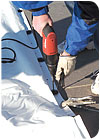
Cool roofing systems extend the useful life of commercial roofs by slowing the rate of degradation by up to 75 percent. They do this by reflecting UV and IR radiation and by preventing moisture penetration.

Since cool roofing surfaces can be up to 80 degrees cooler than black surfaces on hot summer days, they not only improve the performance of most types of roofing insulation by 25 to 50 percent, they also enable rooftop cooling equipment to run more efficiently and may reduce the cooling equipment capacity requirements.
But there are many additional, less publicized benefits to high-performance cool roofing systems. Field experience and ongoing research indicate that the best cool roofing systems enhance the performance of all the elements of high-performance roofing (HPR): energy, environment, endurance, and economics, and improve the performance of other components of high-performance buildings.

The 81,803-square-foot cool roofing system protecting Enid High School in Enid, Okla., was part of a contract for more than 700,000 square feet of roofing covering 22 Enid public schools. After a competitive bidding process, the school district selected a high-performance PVC thermoplastic single-ply cool roofing system, primarily because it could be installed easily, with a full warranty, over existing roofs, and because it had a long-term track record of leak-proof performance in extreme hot and cold weather.
Extra Energy Savings
For instance, did you know that reflective roofing surfaces actually improve the performance of the underlying insulation? High surface temperatures lower the effective R-value of most types of insulation in use today. Because cool roofing surfaces are up to 80 degrees cooler than black surfaces on hot days, recent studies have shown that the insulation underneath can be 25 to 50 percent more effective at resisting thermal conductivity under summer heat loads.Cool roofs can also reduce the capacity requirements for a building’s HVAC system, according to HVAC equipment manufacturer York International. As rooftop temperatures rise above 95 degrees Fahrenheit, rooftop air conditioning efficiency drops. With traditional black roofs, which can reach temperatures of 180 degrees or more, the HVAC inlet air temperature at 30 inches above the roof surface can be up to 15 degrees hotter than reflective cool roofs. This is why cool roofing systems enable rooftop cooling equipment to run more efficiently, and may reduce the cooling equipment capacity requirements.

CR Duro High
The Recycling Benefit
Another overlooked advantage of two popular cool roofing systems: thermoplastic olefin (TPO) and polyvinyl chloride (PVC) thermoplastic systems, is potential recycling and reuse. In fact, both metal and thermoplastic roofing materials are easily recyclable in the plant, after installation and after the roof’s useful service. New technologies have made it possible for thermoset (typically, EPDM) single-plies to be recycled as well.Some manufacturers of metal and thermoplastic roofing systems have initiated recycling programs. This is important, considering that roofing materials are among the largest waste categories found in American landfills - between nine and 10 million tons a year of asphalt roofing waste alone.
Does Endurance EQUAL Green?
Most green building experts contend that longevity is among the most important factors contributing to the sustainability of any building product. Long-lasting roofs reduce the rate of landfill waste buildup as well as the demand for re-roofing projects.What does this have to do with cool roofing? Plenty! While some cool roofing systems are relatively new, PVC single plies have a track record of long, reliable service stretching back to the late 1960s.
Newer reflective roofing systems may demonstrate similar track records. Recent studies have found that the rate of deterioration of substrate materials due to ultraviolet (UV) radiation, infrared (IR) radiation and moisture penetration can be slowed by as much as 75 percent with reflective roofing. Cool roofing systems slow the rate of degradation by reflecting UV and IR radiation, and by preventing moisture penetration. Further long-term studies are needed to determine how much longer cool roofs may last as a result.
Does Endurance EQUAL Economics?
Of course! The longer a roof lasts, the lower its average annual cost: assuming no major repairs is needed. Building owners know this. They cited lifecycle costs as the third most important consideration, behind installed cost and quality of installation, in a 2005 Roofing Industry Alliance for Progress survey.The enormous potential savings of long-lasting, high-performance cool roofing systems are increasingly apparent to building owners. The math is simple: If cool roofing reduces annual electric bills by $1,500, the savings over 20 years total $30,000 without considering rising energy costs. If annual savings are $2,500 a year, 20-year savings are at least $50,000. Powerful incentives!
The advantages of cool roofing suggest that its popularity will continue to grow, and there are many more "stealth" benefits, ranging from improved indoor air quality and comfort to healthier aquatic ecosystems in and around urban areas. Annual energy savings and mitigation of urban heat islands may be the main drivers for cool roofing growth, but there are many other good reasons to consider cool roofing solutions.
Report Abusive Comment